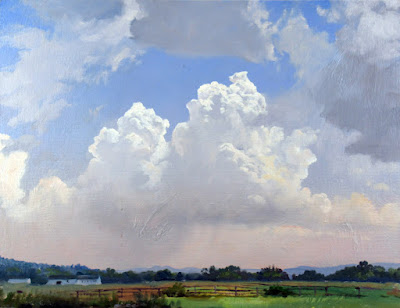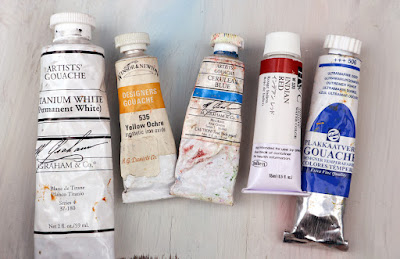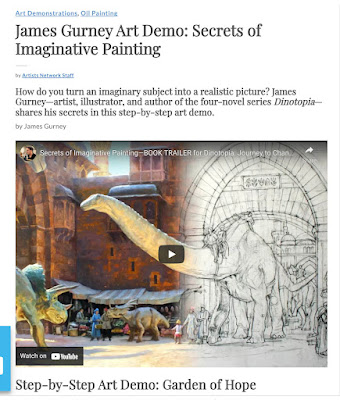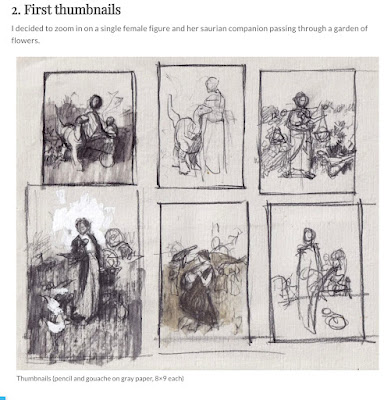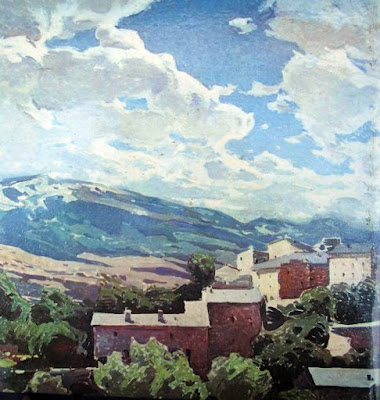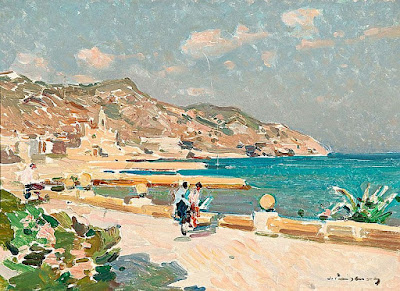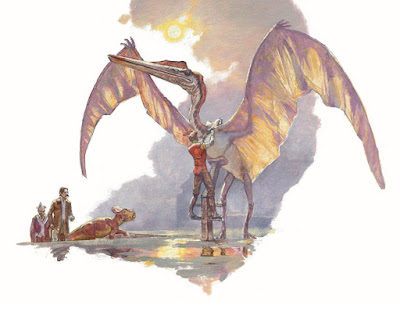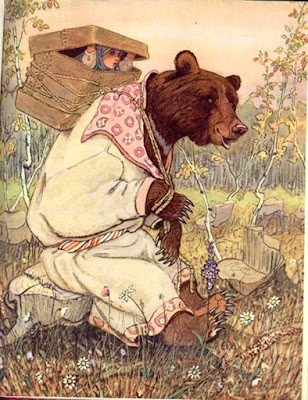Monday, February 28, 2022
What Are You Looking At?
Sunday, February 27, 2022
Strategy for Combining Materials
J.G.: Good question, Orling. In my sketching kit, I bring art supplies that are totally cross-compatible: a fountain pen, water-soluble colored pencils and graphite pencils, water brushes (one with water and a couple others with water-soluble colored inks), a small Schmincke watercolor pan set, and a few tubes of gouache. I also have an oil painting kit, but that's totally separate.
Basic thinking: there is no line between drawing and painting, and there are no “purist” rules. Anything goes as long as it’s conservationally sound. I do go by feel and I use whatever media or methods convey the most information or mood in the time available. And of course, I only bring out what is reasonable to use in a given situation, such as a concert hall, a subway, or a restaurant.
Choosing suitable materials and methods means matching the demands of the subject with the effects I’m likely to get from a given combination of materials. Testing in the studio is key to this non-traditional approach; that’s why I’ve been demonstrating testing and experimentation in my recent Gumroad videos.
Saturday, February 26, 2022
Painting a Thunderhead
Over the two hour period of this painting, the scene rapidly changed from minute to minute. As soon as I had the shapes established, I had to paint the details from memory. But I can keep studying the scene for the overall color relationships.
Thunderheads, plein-air oil, 16 x 20 inch.
Brightest whites and sharpest details are reserved for the emerging billows at the top. Purer white colors of the closer clouds transition more toward warm pink or dull orange as the clouds go back in space. Light that has traveled farther has lost more of its cool wavelengths through scattering.With these cumulus castellanus thunderheads, I look for the fractus shreds of old clouds sheared off by wind currents, dissolving back into the air, the other side of the cloud’s life cycle of growth and decay. They lack the compact density of the billowing clouds, and are never as white.
Thursday, February 24, 2022
Dream Tenders
If you are an overnight guest in Chandara's Imperial Palace, you're greeted by a dream tender, a mysterious courtier dressed to match a feathered dinosaur.
An hour before you go to sleep, your dream tender invites you to tour a gallery filled with various groupings of flowers, essential oils, and paintings.
The idea is to choose the dreamscape you want to inhabit and to fill your senses with the aromas and images, tapping into the deeper core of your memory and emotion.
From Dinotopia: Journey to Chandara
Wednesday, February 23, 2022
Making the Commonplace Unusual
Tuesday, February 22, 2022
Monstrous Transformation
Monday, February 21, 2022
The Architecture of Trees
The design of any plant has to respond to four main physical constraints:
1) Plants have to capture sunlight and avoid shading their own leaves,
2) Plants have to support themselves structurally,
3) Plants have to conduct water to their various tissues, and
4) Plants must be able to reproduce effectively. (source)
Sunday, February 20, 2022
Behind the Scenes of the Iceboat Paintings
Reactivation test: cad yellow / ultra blue, overpainted with water.
These are from the new Gumroad tutorial video "5 Problems with Gouache and How to Solve Them."
Saturday, February 19, 2022
Erasers Leave an Oily Residue
Many erasers leave an oily residue, which can result in paint chipping from its backing surface.
Note how the gouache paint on this Coby Whitmore is chipping off the girl's hair and the background.
Friday, February 18, 2022
Experimenting with Gouache
Thursday, February 17, 2022
YouTube Premiere Tomorrow at Noon
Tomorrow, Feb. 18, at noon EST on YouTube, I'll do a 1-hour demo with gouache and answer your questions about it.
Here's the link.
Wednesday, February 16, 2022
YouTube Premiere Friday at Noon: "5 Problems with Gouache"
I'll be launching a YouTube premiere this Friday (Feb 18) at noon, New York time. The topic will be "5 Problems with Gouache, and How to Solve Them." Gouache presents at least five difficulties: it freezes, it dries fast, it reactivates, it looks chalky, and it shifts values when it dries. I'll deal with each of these challenges and answer your questions and comments as I paint Hudson River iceboats on the frozen river. Have your questions ready. It will be a lively chat.
Tuesday, February 15, 2022
Article in Artists Network
Mucha: 'The Purpose of My Work'
Monday, February 14, 2022
Attentional Spotlight
We bestow our visual attention very selectively, and that hierarchy of awareness is called the attentional (or foveal) spotlight. It's like exploring a pitch-black house at night with a narrow-beamed flashlight.
The fovea is the central spot of the retina, which is packed with photoreceptors, especially color receptors. In the peripheral retina there are fewer receptors, and they tend to be more responsive to tone and movement.
As I understand it, the attentional spotlight is more than just a structural feature of our photoreceptors. It also describes an aspect of our cognitive awareness of the world around us; some would say it's a central quality of consciousness itself. We focus our attention on elements of our world that match our conscious or unconscious search parameters, or distractions that pop up, competing for attention.
Painters can capture the experience of the attentional spotlight, by helping the viewer know what's important, and downplaying the rest. It helps to darken, simplify, or blur areas that are less important. In the painting by Robert Blum, look at how much he downplays the peripheral areas in the foreground, and below the chairs, and keeps our attention within the circle of illuminated faces and hands.
Saturday, February 12, 2022
Jamie Wyeth's Paintings on Cardboard
Quotes are from the Artist Network blog: Artists Network Blog
Image: Andy Warhol Drawing, Jamie Wyeth, 2018. Acrylic, gouache, watercolor and graphite on Crescent toned paperboard, 49.5 × 39.4 cm.
Friday, February 11, 2022
Light Pillars
Thursday, February 10, 2022
The Skies of Josep Puigdengolas
Simple flat colors show the bones of his thinking. Painting on a warm ground, he places a light cloud mass and a blue sky, but leaves a warm fringe all around. The washes of milky paint in the foreground let the warm ground shine through.
Since there's no Wikipedia page on Josep Puigdengolas, here's a little more, translated from Todo Coleccion: "He studied at the Royal Academy of Fine Arts in Florence. He had his studio in Barcelona but lived for periods in Mallorca and Sardinia. In 1951 he was appointed Professor at the Superior School of Fine Arts of San Jorge in Barcelona."
Wednesday, February 9, 2022
Sunbeams in a Forest

Sunbeams influence pick out random elements of the scene to spotlight, and they lighten the values of everything beyond them.
Using traditional oil paint, this can be accomplished by scumbling a light, semi-opaque shape over the dry background where the beams appear. However, white pigment will reduce the chroma and make it chalky, so the color may need to be restored by glazing.
Alternately the colors can be achieved by careful premixing. In this painting, I premixed one string of colors for the areas inside the sunbeam, and a whole separate string for the colors of the darker unlit forest.
--
Previous post on Scumbling
Tuesday, February 8, 2022
Coming Up In Artists Magazine
In includes a review of the Enchantment exhibition that will be at the Hunter Museum in Tennessee this spring and a behind-the-scenes look at the making of Garden of Hope and Skeleton Pirate.
Monday, February 7, 2022
The Torn Paper Vignette
I wanted to show the misty atmosphere of the setting without a full rectangular shaped composition, so I used a "torn paper vignette," cutting out a ragged piece of the background behind Will and his skybax.
---
Vignetting Strategies (3-Part Blog Series)
Sunday, February 6, 2022
Animal Fable Illustrations by E.M. Rachev
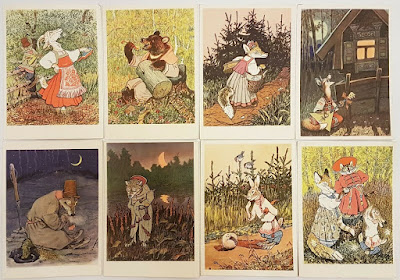
Postcards based on Russian folk tales, 1960, E.M. Rachev.
He used animal characters to tell his stories, but of course the allegories were really about human foibles.
"He remembered Siberia as a fantastic land. Black grouses sitting pompously on fir branches in the evenings... Fish and wild ducks swarming the lakes... No end to mushrooms and berries in summer... But when the boy was 14 years old his grandmother died. He decided to go to his mother who at that time lived in Novorosiisk. It took him three months to get there through Russia ravaged by the revolution." |
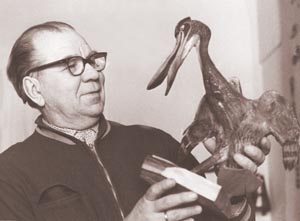
Saturday, February 5, 2022
Brain Scanners that Recognize What You Have Looked At.
In recent years, brain imaging studies have been able to recognize what image a person is looking at purely from brain activity. This is possible because the image maps onto the visual cortex almost like a blurry projection.
But now scientists have gone a step further. Researchers studying patterns of brain activity can correctly identify what image you have seen in the past, or even what image you're imagining, based on brain activity.The research examines how you remember — and imagine— pictures that you've actually seen. It turns out that similar mechanisms come into play when you imagine something compared to how you process the real thing.
The scanning system is still in its infancy, but it portends the kind of mind-reading device described by science fiction authors. "It's what you would actually use if you were going to build a functional brain-reading device," said Jack Gallant, a neuroscientist from the University of California, Berkeley.
CNN: Brain scans reveal what you've seen
Brain Inspired Podcast: Thomas Naselaris | Seeing vs. Imagining
Friday, February 4, 2022
Snow Shadows and Frost Shadows
Sometimes nature presents visual situations that could easily be mistaken for something else. If you painted them, it would look like you made a mistake.
Thursday, February 3, 2022
Crowdsourcing Lights for Plein-Air Nocturnes
I answer: I don't know to be honest, since everything is changing so fast in the LED space. Anybody have a suggestion for good book light or headlamp with adjustable light levels?
Cleve Page answers: "I got a Lumecube 2.0. It has adjustable light levels and there are attachments like barn doors or snap-on color filters. It's an excellent product. It also has 1/4-20 threads so you can add it to a separate structure. It's more pricey than a headlamp, but it's much more capable."
 Fiona Fleming adds: "I just purchased a Vekkia 19 LED Music Stand Light with a nice substantial clip, and a flexible arm…the light alters to warm, medium or cool and can be directed right onto the surface. I haven’t road tested it on the easel at night yet, but I might tonight! It charges with a USB cable."
Fiona Fleming adds: "I just purchased a Vekkia 19 LED Music Stand Light with a nice substantial clip, and a flexible arm…the light alters to warm, medium or cool and can be directed right onto the surface. I haven’t road tested it on the easel at night yet, but I might tonight! It charges with a USB cable."- Drew Baker I've mused about putting something using srtip LEDs from Waveformlighting. My thinking is a very high CRI source would be a better approach than something with tunable temperature and questionable CRI.
- The issue with most lights is the bulb is exposed, which is blinding if you have an audience, this light has it in a recess so all the light is directed towards the paper. Prior to this I was setting up a hood.
Julie Bloch I got little clip on rechargeable LED lights that are tiny. I bought 2 for my plein-air backpack.
Damian Kinsella I try to limit the light as much as possible so these do well to not give me so much light that I lose the sense of what I'm looking at. Eric Merrell brought up the idea of taping a piece of vellum over them and that diffuses the light a bit more and warms it up slightly as well (depending on the vellum). They don't work well with my Yarka rig, but for a Gurney-style flip easel they're practically perfect.
Edgeprogear sells a light for their pochade boxes. It's essentially a Vidpro LED-230 on a gooseneck, with a bespoke mount for the Paintbook. (At least, that's what mine is.)
The last one I got is the best so far, its designed for musicians, its battery on bright lasts an entire session of 5 hours, and it goes from 4 to 3 on its power display, I have used it two sessions in a row without recharging.
(photos from Brian Meyer)
Vekkia clip-on book light.
- The kit I purchased can run off the included 12-hour lithium batteries so this would allow painting on location far away from any other electrical source for an extended period of time.
- Although I haven't used them for an en plein air nocturne, I do plein air oils and am always looking for an efficient means of transporting my gear. I can envision these old bones including such a light in an excursion. The kit essentially could be doing triple-duty (copywork, studio painting, and night painting on location) if I decide to try a nocturne. Their use in conjunction with polarizing filters on the lights and camera lens makes a remarkable improvement when copying art. Because of such versatility, they may be worth consideration.
- I paint at night, at concerts, etc. Basically I have bought every light you can get.The ones I prefer now are rechargeable, which can last 2-3 hours.
- The last one I got is the best so far, its designed for musicians, its battery on bright lasts an entire session of 5 hours, and it goes from 4 to 3 on its power display, I have used it two sessions in a row without recharging.
- Good for extra light, like on your palette and paint mixing areas, or as a backup main light. Its also better light, good for when recording with a GoPro.
Always plan on the batteries dying and have a spare.
Wednesday, February 2, 2022
How Can I Learn Painting Without Art School?
It's hard for me to say without knowing more about you and your circumstances. Here's my own experience. Although I went briefly to art school, I learned mainly from books and lots of practice and trial and error.
 My way of learning new skills is to limit the variables and experiment in a playful way so that I can solve the problems one by one and try out new combinations. For painting, I recommend starting off with black and white first, then adding simple complementary schemes, then triads, etc. I would suggest alternating between oil paint and a water medium like gouache, with lots of pencil drawing too.
My way of learning new skills is to limit the variables and experiment in a playful way so that I can solve the problems one by one and try out new combinations. For painting, I recommend starting off with black and white first, then adding simple complementary schemes, then triads, etc. I would suggest alternating between oil paint and a water medium like gouache, with lots of pencil drawing too.










